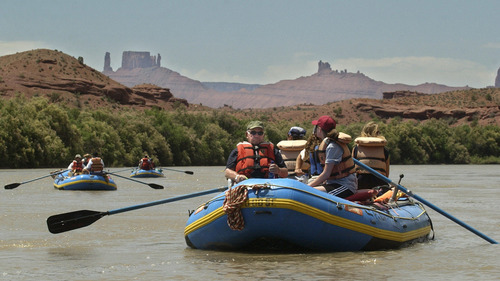This is an archived article that was published on sltrib.com in 2012, and information in the article may be outdated. It is provided only for personal research purposes and may not be reprinted.
Imagine life in Utah without the spectacular recreational opportunities the Colorado River and its tributaries provide — whether they be boating, fishing, hiking or picnicking nearby.
A new study places a dollar value — $26 billion — on the river's worth to recreation-related industries in the six-state region through which it flows.
The study by Southwick Associates Inc., a Florida-based company specializing in natural resource and environmental economics, says 234,000 people in Utah, Arizona, Colorado, Nevada, New Mexico and Wyoming work in Colorado River-related industries.
Another 5.6 million adults — or one in three who live in the region — spent money recreating on or around the river last year.
Compared with the 2011 Fortune 500, "Colorado River Inc." would rank 19th in terms of jobs and 155th for retail sales, says the study, commissioned by Protect the Flows, a coalition of about 400 small businesses working to protect the river.
Protect the Flows coordinator Molly Mugglestone characterized the looming water crisis during a Friday conference call about the study.
"Demand now far outweighs the river supply and Department of Interior estimates show this trend is getting worse, not better," Mugglestone said.
Stored water on the river has dropped about 35 percent over the past 12 years, she said, adding that the consequences of the current trajectory will be far-reaching.
About 36 million Americans depend on the Colorado River network for drinking water, Mugglestone said, and the system irrigates 12 percent of the nation's crops.
"If we do nothing, the price of water will spike, rural agricultural communities will become less viable, households will be forced to make drastic changes in how they use water and businesses around this table will be hurt," she warned.
The U.S. Bureau of Reclamation is expected to release its Colorado River supply and demand study this summer. Protect the Flows hopes to build awareness about the river network not only as a precious water source but also as the lifeblood of the six-state region's economy.
Its impact on jobs goes beyond recreation-related industries, Sarah Sidwell, manager of Tag A Long Expeditions in Moab, said during Friday's call.
Tourists gravitate to Moab for its access to recreation, while manufacturing, technology and health-oriented companies also are locating there because of its attractive quality of life, Sidwell said.
The economy in general relies on the river running well, she said.
Fretting over water's "nonconsumptive" uses may lead some to scoff, Sen. Mark Udall, D-Colo., said during Friday's call.
"It's tough to know the value of water until it's gone," he said, "but the Southwick report starts to put some good numbers on the economic effect of keeping water in our rivers. Hopefully we can convert some of the cynics out there."
cmckitrick@sltrib.comTwitter: @catmck —
By the numbers • Utah and the Colorado River in 2011
768,000
number of Utahns (41 percent of the state's population) who used the river for recreation
34,100 number of Utahns employed by river-related businesses
$1.3B labor income from river-related jobs
$2.1B direct spending from river-related recreation
$428M federal, state and local taxes generated by river-related recreation
Source • Colorado River Inc. report bySouthwick Associates Inc.



